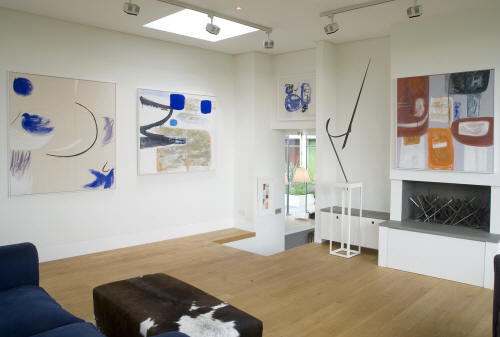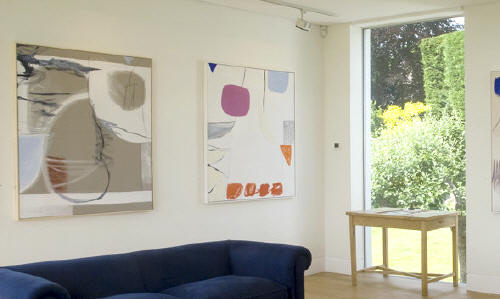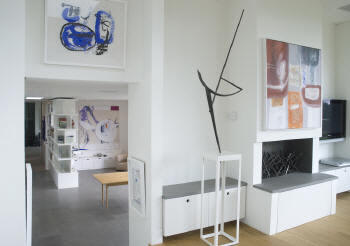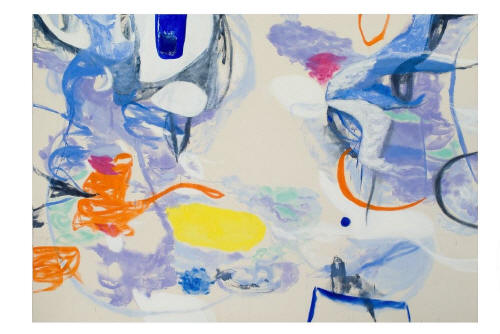|
|
| home | features | exhibitions | interviews | profiles | webprojects | gazetteer | links | archive | forum |
|
Lightness of Being: Felicity Mara’s Lyrical Abstraction Helen Dunmore
This passage from southern coast to
northern is the landscape of Felicity Mara’s painting 'The Journey
Home', where winter light pierces through bold curves which echo these
distinctive Penwith contours. The painting
Mara’s studio is in a former telephone
exchange, where the austerity of the space is illuminated by the colour,
form and line of her work. Certain notes of colour recur. There are bold
punctuations of ultramarine; clear, singing yellow; cellobrown; a
wonderfully subtle range of greys and blues; lavender, orange, violet
and magenta. Her colouring is exhilarating: she uses acrylics with the
opacity of tempera, as well as oils, and allows the luminosity of the
ground to glow through the painted surface. Sometimes she sprays an
unprimed canvas with water to give fluidity to the paint. Line is a striking feature of her work.
There’s strong sense of drawing in these paintings: of a line searched
out and followed; of shapes reduced and simplified into potent motifs
which grow more and more eloquent
Another recurring theme is the sea. Mara’s handling of this hugely evocative presence moves effortlessly between the figurative and the abstract without settling on either. Her gift for lyrical abstraction means that certain motifs – a harbour entrance, a blue triangle in a fold of hills, a bay framed by window or curtains – combine a subtle, even symbolic resonance with formal power. The longing and sense of mystery aroused by the sea are very powerful in these paintings. In 'Nightscape', the little boat seems to be rocked in the cradle of the painting’s rich, subtle blues, while at the same time it sets out on a voyage for a hidden country. In other paintings, curtains billow, concealing the sweep of a tide, or water ebbs from pale sand, leaving reflected forms.
Influences as diverse as Miró, Bonnard and Frankenthaler inform the work. Chagall’s blend of luminosity and earthiness is another presence, but Mara’s poetic quality and depth of colour and line connect very deeply to the place where these paintings were made. Mara infuses her work with the landscape’s worn, rounded hills, its sudden, breathtaking transformations of light, and with illuminations from a sea that is never more than a few miles away. Without being a landscape painter in a descriptive sense, she is an artist whose absorption of a unique landscape forms part of a extraordinary and beguiling painterly journey.
Felicity Mara was born in London and studied Fine Art at Camberwell School of Art and Crafts. She had her first exhibition at the New Ashgate Gallery, Farnham. In 1994 she moved to Cornwall, where she continues to live and work. This essay was written to coincide with her exhibition at Chalk Hill Contemporary Art in Summer 2008 (photographs above courtesy Annabel Agace). Helen Dunmore is author of ten novels, including 'Zennor in Darkness', which won the McKitterick Prize, and A Spell of Winter, winner of the 1996 Orange Prize. She is also a poet and children’s writer. Her recent books include the poetry collection Glad of these Times and the novel 'Counting the Stars'.
|
|
|




